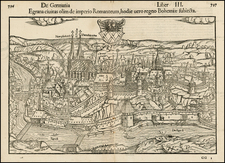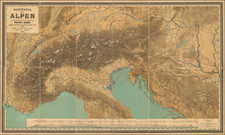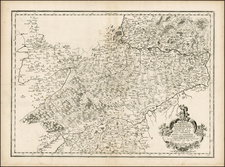Moll's Map of the Holy Roman Empire
Detailed map of the German Empire, by Herman Moll, published in London.
The complete empire is shown on a large scale. Moll offers additional information about many regions by naming the resource primarily associated with it, for example, beer with Hamburg and salt with Trieste. Furthermore, he locates many copper, iron and silver mines. The map also includes the route taken by the great general John Churchill (1650-1722) in the 1704 campaign during the War of the Spanish Succession, noting the battles with, of course, the Battle of Blenheim. The map is dedicated to Marlborough and portrays him on his horse crushing his adversaries.
The inset view of "the General Diet of the Empire or Parliament..." compares the Electoral College with the English Parliament. Over the doorway is a sign which reads, "The Liberty of Germany". "The Publick Good" and "the Comon Necessity" are two figures standing in the doorway. Within is a large gathering of ecclesiastical and secular princes and the nine Electors, the most recent addition to the Electorate being the Elector of Hanover, as of 1692. The Elector of Hanover at the time the map was made was to become George I of Great Britain.
Herman Moll (c. 1654-1732) was one of the most important London mapmakers in the first half of the eighteenth century. Moll was probably born in Bremen, Germany, around 1654. He moved to London to escape the Scanian Wars. His earliest work was as an engraver for Moses Pitt on the production of the English Atlas, a failed work which landed Pitt in debtor's prison. Moll also engraved for Sir Jonas Moore, Grenville Collins, John Adair, and the Seller & Price firm. He published his first original maps in the early 1680s and had set up his own shop by the 1690s.
Moll's work quickly helped him become a member of a group which congregated at Jonathan's Coffee House at Number 20 Exchange Alley, Cornhill, where speculators met to trade stock. Moll's circle included the scientist Robert Hooke, the archaeologist William Stuckley, the authors Jonathan Swift and Daniel Defoe, and the intellectually-gifted pirates William Dampier, Woodes Rogers and William Hacke. From these contacts, Moll gained a great deal of privileged information that was included in his maps.
Over the course of his career, he published dozens of geographies, atlases, and histories, not to mention numerous sheet maps. His most famous works are Atlas Geographus, a monthly magazine that ran from 1708 to 1717, and The World Described (1715-54). He also frequently made maps for books, including those of Dampier’s publications and Swift’s Gulliver’s Travels. Moll died in 1732. It is likely that his plates passed to another contemporary, Thomas Bowles, after this death.











![[ Switzerland ] Carte du Pais De Vallais ou Wallisser-Land . . .](https://storage.googleapis.com/raremaps/img/small/0051gh.jpg)
![[ Northeastern Moldova ] Des Furstenthums Moldau Noerdiliche Haelfte Nro. 9](https://storage.googleapis.com/raremaps/img/small/101869.jpg)



